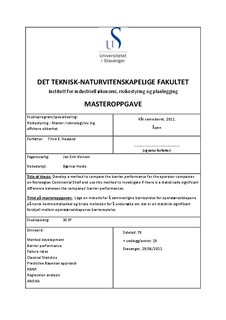| dc.contributor.author | Haaland, Trine Elisabeth | |
| dc.date.accessioned | 2011-10-10T14:52:17Z | |
| dc.date.available | 2011-10-10T14:52:17Z | |
| dc.date.issued | 2011 | |
| dc.identifier.uri | http://hdl.handle.net/11250/182050 | |
| dc.description | Master's thesis in Risk management | en_US |
| dc.description.abstract | In this thesis a method has been developed to investigate if there is a statistically significant difference between the barrier performances of different operator companies.
The method is developed using the predictive Bayesian approach, as described in Aven (2003). It includes two formulas; one formula for the prediction interval, which will be used to compare the operators’ failure rates, and the second formula for making a criterion to define the number of tests required in order to obtain an acceptable level for the failure rates. The method is comparable to the classical methods of “tests of two proportions” and “choice of sample size”.
The Classical approach has also been compared to the predictive Bayesian approach. The predictive Bayesian approach uses the previous data as background knowledge to find the predicted value of p. It could be argued that the predictive Bayesian approach is more reliable than the Classical approach because the result from the predictive Bayesian approach tries to describe how the states of the observable quantities are at present or in the future. The Classical approach on the other hand only calculates the probability as it was, implicitly excluding the evolution of the events.
The method, in its essence, compares two of the operators’ failure rates at a time, for seven barriers. It determines the operator which has a statistically significant lower failure rate. The method has its main motivation in assuming that operator companies will show trends that reveal different maintenance, inspection and testing schemes and expertise for the barriers.
The results from the developed method show that three comparisons of the operators’ barrier performance were found to have a statistically significant lower failure rate, while the results from the Classical approach found twelve such comparisons that showed a statistically significant lower failure rate. The Classical approach found more comparisons with statistically significant lower failure rates, because the developed method performed fewer comparisons due to the criterion for number of tests for next period was not fulfilled for each comparison. However, the developed method results in the same conclusions as the Classical approach, but the Classical approach gives more exaggerated indications compared to the developed method. | en_US |
| dc.language.iso | eng | en_US |
| dc.publisher | University of Stavanger, Norway | en_US |
| dc.relation.ispartofseries | Masteroppgave/UIS-TN-IØRP/2011; | |
| dc.subject | method development | en_US |
| dc.subject | barrier performance | en_US |
| dc.subject | failure rates | en_US |
| dc.subject | classical statistics | en_US |
| dc.subject | predictive bayesian approach | en_US |
| dc.subject | RNNP | en_US |
| dc.subject | regression analysis | en_US |
| dc.subject | ANOVA | en_US |
| dc.subject | risikostyring | en_US |
| dc.title | Develop a method to compare the barrier performance for the operator companies on Norwegian Continental Shelf and use this method to investigate if there is a statistically significant difference between the companys’ barrier performances. | en_US |
| dc.type | Master thesis | en_US |
| dc.subject.nsi | VDP::Technology: 500 | en_US |
